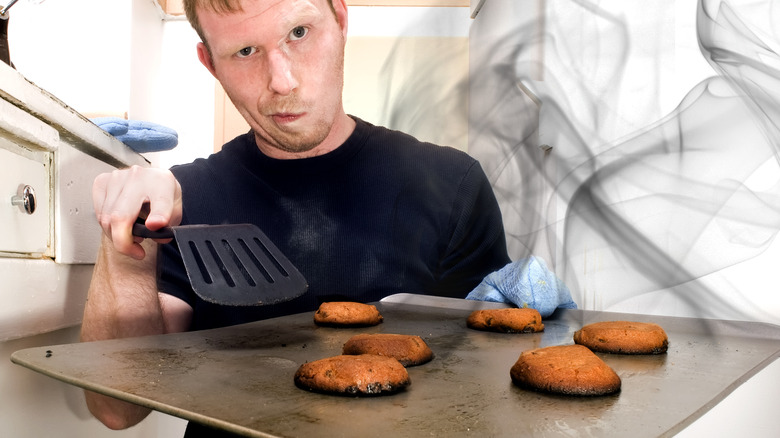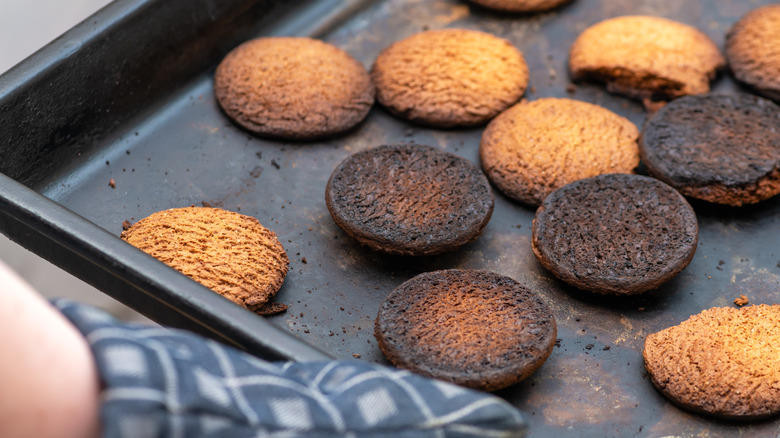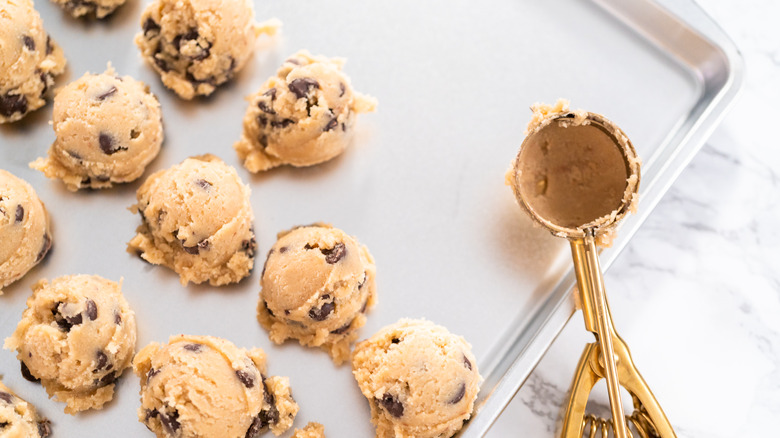The Real Reason Your Cookie Edges Are Burning
According to The Cravory Cookies, roughly 93% of households in the United States indulge in cookies as a stand-alone treat or as an after-meal dessert. The popularity of cookies explains the success of legendary brands like Toll House and Nestle, as well as newer franchises like Insomnia Cookies and Crumbl Cookies. When it comes to flavor, chocolate chip cookies reign supreme, with peanut butter and oatmeal cookies coming in at a distant second and third place.
No matter the variety, close your eyes and imagine biting into your favorite mouthwatering cookie — a tasty treat infused with your preferred topping, the satisfying crunch and soft gooey center you crave leaving you speechless bite after bite. With all that in mind, we bet the last thing you imagined was burnt edges. Regardless of experience, the bitter taste of a burnt cookie is a nightmare for many bakers (and snackers).
So, why do cookie edges burn, and how can we prevent it?
Too hot to handle
Believe it or not, the external environment can play a vital role in determining whether your cookies will burn or not. That doesn't mean your oven was too hot, although you should always rule that out first. But Cooks Illustrated cautions that if your kitchen itself is too hot, it could cause the butter in your cookie dough to melt quickly, which has an adverse downstream effect.
When the butter melts faster than intended, this causes the dough to become too soft and spread too quickly, which leaves the edges susceptible to burning (via Fine Cooking). However, all hope is not lost. An easy remedy is to allow your dough to chill for 10 to 15 minutes before preparing it to go in the oven.
Aside from the temperature of your kitchen, the temperature of the baking sheet you use also matters. The biggest problem with baking sheet temperature arises when you're making multiple batches of cookies successively. The consequence of raw cookie dough on an already warm baking sheet is that the cookies will, once again, spread too quickly and finish with crispy, burnt edges. Therefore, it's imperative to allow the baking sheet to cool before adding another batch of dough. If you're in a time crunch, it's okay to rinse the baking sheet with cold tap water. However, only do this when the pan is warm. If it's still piping hot, you could burn yourself on the steam as you wash it.
Do baking sheet colors matter?
In short, yes, they do. When it comes to the issue of burned cookie edges, the surface you place the raw cookie dough on — even down to its color — can affect the quality of your finished cookie.
For baking in general, a darkly-finished baking sheet is preferable due to its ability to absorb heat better than its light-colored counterparts. However, cookies are the exception: A darker sheet can cause the bottom of the cookie to over-brown or, worse, burn. Even dark nonstick baking sheets are prone to over-browning the bottom of the cookies.
To avoid this, using a light-colored baking sheet would be the obvious solution. However, that's only part of it. According to Cooks Illustrated, light-colored baking sheets effectively prevent burning but also make cookies more likely to stick to the sheet. You can remedy this quickly by lining the baking sheet with parchment paper. The combination of the light baking sheet and parchment paper will ensure you don't have burnt cookies you can't get off the baking sheet.


